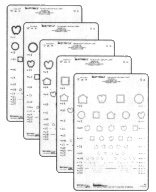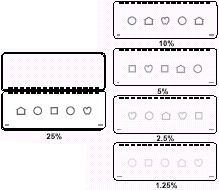
Contrast sensitivity tests
Visual information at low contrast is especially important in visual communication. Therefore testing with Hiding Heidi Low Contrast Face Pictures in infancy and childhood gives important information about the distance at which the child can see facial features.


Contrast sensitivity measurements can first be performed using the Enhancement Game, i.e. single low contrast symbols. At the age of three and half to four years children are able to respond to the usual line tests (Contrast sensitivity in preschool children).
Low contrast optotype tests are either visual acuity charts at low contrast or tests with one symbol size (10M) at different contrast levels. With both tests the measurement of low contrast functioning is quick and easy. The measurement of two points on the contrast sensitivity curve requires only 1-2 minutes.

It is
important to remember that visual acuity as such does not define the quality of form
vision. Children and adult persons with equal visual acuity at high contrast may
have either normal (A), slightly lower (B) or very poor (C) function at low contrast
levels. Thus three persons with the same visual acuity may have very different
vision:
In these three cases one is normally sighted, one has low vision and the third is severely visually impaired.
Click here for the Net version of the Contrast Sensitivity Manual.
Paediatric Vision Tests I Vision Tests I Instructions Section I Main Page